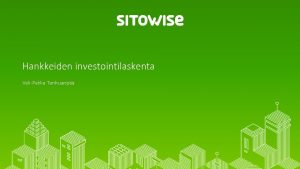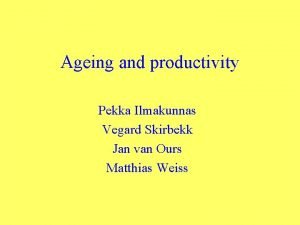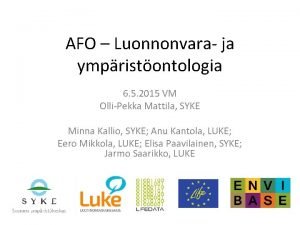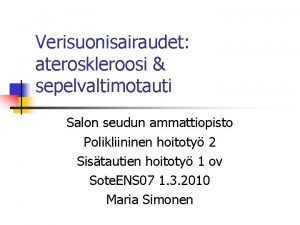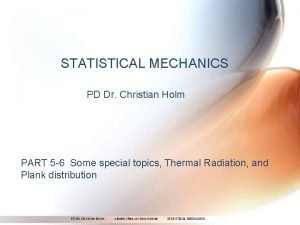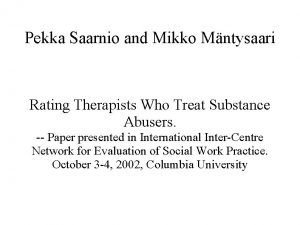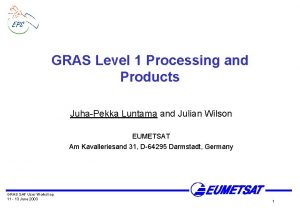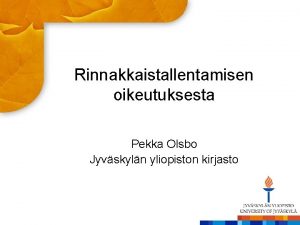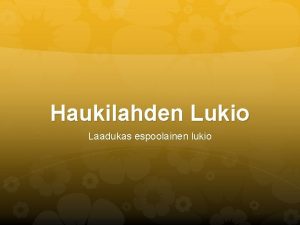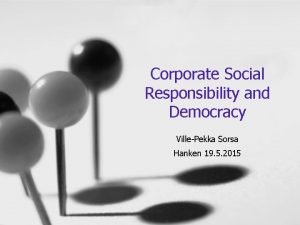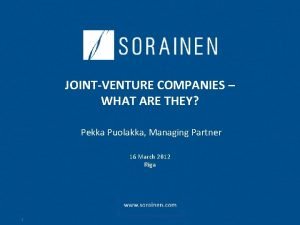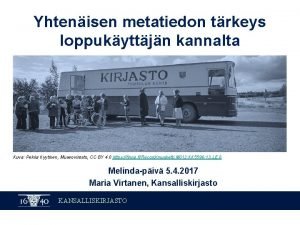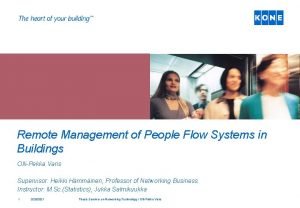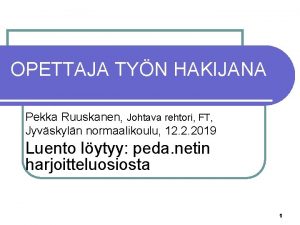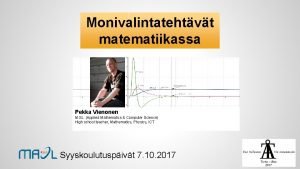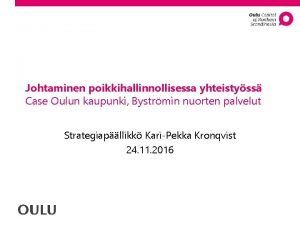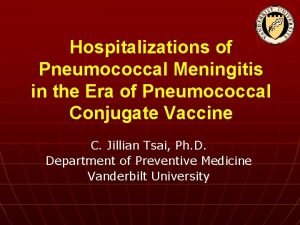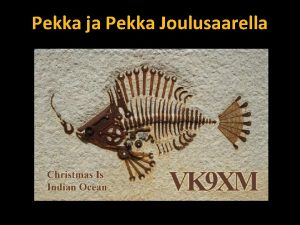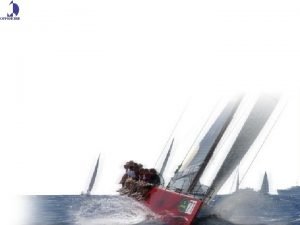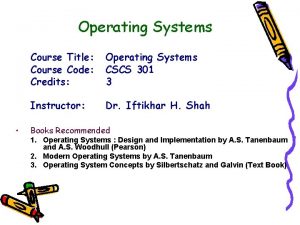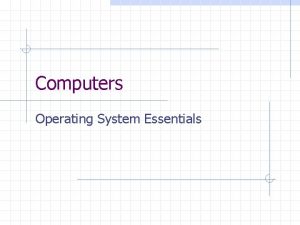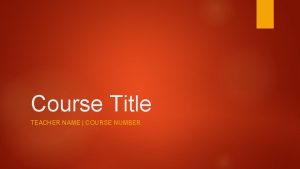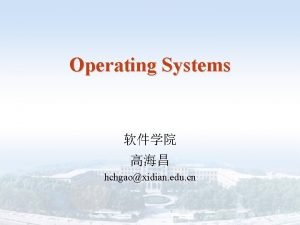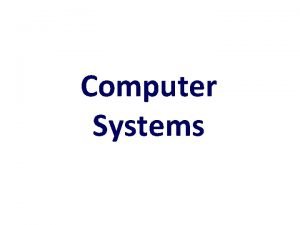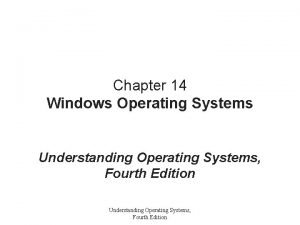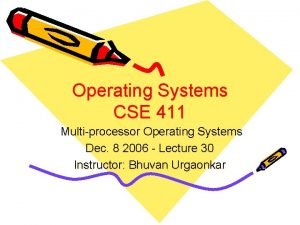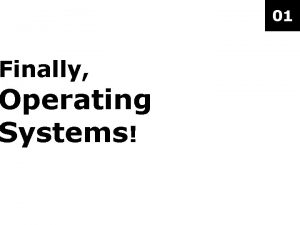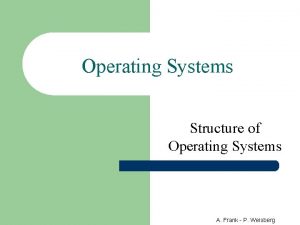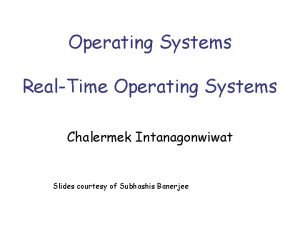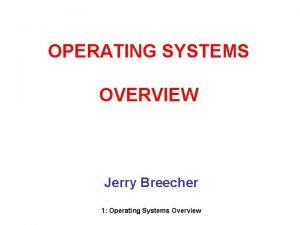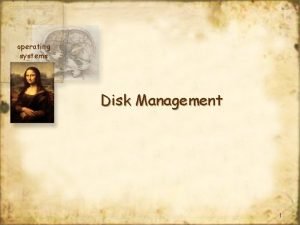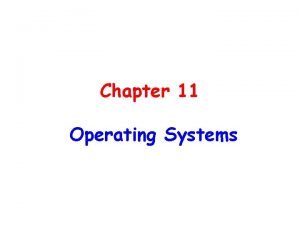Operating systems course Class 1spring 2013 Teacher Pekka























- Slides: 23

Operating systems course Class 1/spring 2013

Teacher: Pekka • Pekka. Makkonen@ttcollege. edu. sa • Skype pmakkone • http: //fi. linkedin. com/pub/pekkamakkonen/24/643/155 • Room 1. 242 • Here at TTC until next summer • Tenure lecturer’s position at the University of Jyvӓskylӓ in Finland (www. jyu. fi) 2

Course content Introduction Windows Processes (next week) THREADS, SMP, AND MICROKERNELS CONCURRENCY: MUTUAL EXCLUSION AND SYNCHRONIZATION • CONCURRENCY: DEADLOCK AND STARVATION • Linux • … (to be updated) • • • 3

Teaching and learning methods • Lectures (as short as possible) • Exercises • Presentations – Oral – On the web • Self-study (for exam especially) • The keypoint is collaborative learning 4

Evaluation • Exam 60% • Exercises 30% • Presence 10% 5

Reference material • Tanenbaum, A. S. Modern operating systems (latest edition). Pearson. • Harris, J. A. Operating systems (latest edition). Mc. Graw-Hill • Material from related course in Finland other countries 6

Today • • Questionnaire Introduction Studying and slide creating exercise Collecting your emails that you can join our wikispaces sites 7

• Today, a computer quite often consist of more than one processors, main memory, disks( Harddisk drives (HDD), memory sticks etc. ), a keyboard, a mouse, a display, network interfaces and other input/output devices. 8

• Windows, Unix, Linux, Free. BSD or Mac OS X or Android and Symbian – Different versions for different purposes • For example Linux – Redhat (for servers) – Ubuntu (for personal computers) – Android (for mobile) – Comparing personal computers and servers – It may be good if you use Windows on your personal computers and Linux on servers. You must also think about security issues and Linux is more safe and that it is good for servers used by many users. 9

• Shell - text based input – In Windows use the command cmd to go to textbased input – You can use old DOS commands such as DIR – In Ubuntu version of Linux you have similar terminal • GUI (Graphical User Interface) - icon, menu based 10

• An operating system is the most fundamental software and runs in kernel mode (supervisor mode). As supervisor , it can execute privileged operations 11

What is an operating system? • It is software that runs in kernel mode • Provides application programmers a clean abstract set of resources instead of a messy hardware ones • Manages hardware • Abstraction is the key to managing complexity. Good abstraction turns a nearly impossible task into two manageable ones. The first one of these is defining and implementing the abstraction. The second one is using these abstractions to solve the problem at hand. 12

• A typical abstraction is a file, or as we handled last term in data structures und algorithms unit things like stacks and linked lists – Application in use is divided into many processes when used on a computer. Each process includes process control block and those process control blocks are in stacks on a computer 13

• The job of the operating system is to create good abstractions and then implement and manage the abstract objects thus created. 14

• Example of abstraction : Linux user running Gnome (http: //en. wikipedia. org/wiki/GNOME) or KDE (http: //en. wikipedia. org/wiki/KDE) sees a very different interface than a Linux user working directly on top of the underlying (text-oriented X Window System), but the underlying operating system abstractions are same in both cases. 15

We can look at an operating system from an alternative view • Than a operating systems function is to provide an orderly and controlled allocation of the processors, memories, and I/O devices among the various programs competing for them. 16

For example • the print manager manages a print queue to ensure that complete print jobs are printed if a printer is shared with other users/ computers. When a computer or network has multiple users, the need for managing and protecting the memory, I/O devices, and other resources is even greater, since the users often need to share not only hardware, but information (files, data bases, etc. ) as well. 17

Multiplexing • An operating system multiplexes hardware resources. • Time Multiplexing: – E. g. , The operating system allocates the CPU to one task at a time, but to each task in its turn. • Space Multiplexing – E. g. , The operating system allocates a part of the memory to each task. • http: //www. comsci. us/os/notes 1/ch 01. html (accessed Dec 31, 2012) 18

History of Operating Systems • The first generation 1945 -55 with vacuum tubes • The second generation 1955 -65 Transistors and batch systems • The third Generation 1965 -1980 ICs and multiprogramming • The fourth Generation 1980 -present – Personal Computers 19

Exercises/Exercise 1 • You will be divided in small groups (6 people in one group) – Tell Pekka the names in your group • Visit http: //os-ttc-13. wikispaces. com/ • Read this material and possible additional material – Select you task and alternate task • Inform Pekka about your task selection (task choices are on next slide) • Study your topic using google. Clarify the following things – What is the meaning of your concept or technology in practice (your slide 2)? – How does a computer benefit from your technology? (your slide 3) – How does your concept or technology is connected to other concepts and technologies? (your slide 4) • When ready, you must present these what you have learnt by using slides (see next pages) – We will talk about your presentations next time 20

Topics • • • Option 1 Shell text-based input Option 2 GUI (Graphical User Interface) Option 3 Kernel mode Option 4 Abstraction Option 5: Multiplexing 21

Your slides • Start slides including the main title and the names in your group • Slide 2 (What is the meaning of your concept or technology in practice) • Slide 3 (How does a computer benefit from your technology? ) • Slide 4 (How does your concept or technology is connected to other concepts and technologies? ) • Slide 5 (Summary-you should summarize your presentationall the things together) • Slide 6 Report how different members in your group participated in the group work. Mention each member separately. 22

Wikispaces • Join Wikispaces if not done before – http: //www. wikispaces. com/content/student • You can go to http: //os-ttc-13. wikispaces. com/ and ask for the invitation there Please notice in this course all the material will be given through http: //os-ttc-13. wikispaces. com/ You must download all the material immediately when published. We do not give softcopies (papers). 23
 Nettokassavirta
Nettokassavirta Pekka ilmakunnas
Pekka ilmakunnas Olli-pekka mattila
Olli-pekka mattila Ckmbm
Ckmbm Dr. christian holm
Dr. christian holm Pekka saarnio
Pekka saarnio Juha-pekka luntama
Juha-pekka luntama Pekka olsbo
Pekka olsbo Haukilahden lukio
Haukilahden lukio Pekka sorsa
Pekka sorsa Pekka puolakka
Pekka puolakka Pekka kyytinen
Pekka kyytinen Varis tools
Varis tools Ansiovertailu malli
Ansiovertailu malli Pekka vienonen
Pekka vienonen Wenwen li
Wenwen li Kari-pekka kronqvist
Kari-pekka kronqvist Pneumococcal
Pneumococcal Erf process
Erf process Good afternoon teacher.
Good afternoon teacher. One and half brick wall
One and half brick wall Course title and course number
Course title and course number Course interne moyenne externe
Course interne moyenne externe Example of an operating system
Example of an operating system
